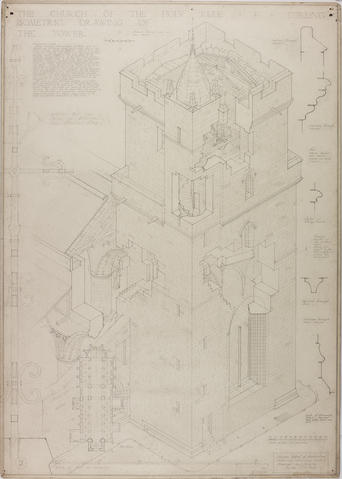License:
 This image is provided under a Creative Commons BY-NC-SA License. You can download this version for private study or non-commercial use. Our terms, conditions and copyright policy (PDF) contains further information about acceptable usage. If you are seeking permission to publish, please contact us ›
This image is provided under a Creative Commons BY-NC-SA License. You can download this version for private study or non-commercial use. Our terms, conditions and copyright policy (PDF) contains further information about acceptable usage. If you are seeking permission to publish, please contact us ›
Please click here if you would like to request a larger, high-resolution version ›
Key Information
Reference code
Title
Date(s)
- 1936 (Creation)
Level of description
Item
Extent
2 of 2
Content and Structure
Scope and content
Isometric drawing of tower.
Appraisal, destruction and scheduling
Accruals
System of arrangement
General Information
Name of creator
Biographical history
Joseph ('Joe') William Bartlay Park was born in Argentina on 6 July 1912, the son of Joseph Park, engine driver, and his wife Elizabeth Anthony. His father had gone to Argentina to train engine drivers on the Argentinian Railway. His father died suddenly three years later and his mother brought her son back to Scotland where she settled in Kilsyth. Park was educated at Kilsyth Academy before enrolling at Glasgow School of Architecture where in later years he was to become a lecturer. He was an Associate of the Glasgow Institute of Architects in 1939-40 and his address at that date was 117 Low Craigends, Kilsyth. He did not become a member of the RIBA. During the Second World War Park served as a radio officer in the Merchant Navy, particularly on the Murmansk Convoys. He was 'modestly reticent' about this experience but when he was in his mid-sixties he did remark that after his time on these convoys he never felt the cold again. Park worked both in private practice and as burgh architect in Kilsyth and designed a number of buildings there. In the 1950s he was instrumental in saving Colzium House when it was badly affected by dry rot, an early conservation archievement. He was elected FRIAS in 1957. In 1970 he joined his practice with that of James Robert Clunie Rowell and John Maxwell Anderson. David Laidlaw Baird also joined the new partnership, the practice title being Park Rowell Baird & Partners. Park's obituarist, Professor Andrew MacMillan remembers Park: 'small and bearded, Joe was a charismatic figure impressing his students as much by his Volvo driving life style as his commitment to their wefare or his passion for the history of Architecture, particularly the Medieval and the Early Christian. He was in fact himself a practising Christian and a senior elder in his church to which he gave much service'. After his retirement from the School of Architecture he established a scholarship to be awarded for exemplary performance in the part-time architecture course. By the time of his death at Stobhill Hospital on 11 December 1996 he was a retired Fellow of the RIAS. He was a lecturer for many years at the Glasgow School of Architecture. He was a widower (his wife Margaret Taggart having died several years before) but was survived by his daughters and grandchildren.
Archival history
Custodial history
Physical Description and Conditions of Use
Conditions governing access
Conditions governing reproduction
Language of material
Script of material
Language and script notes
Physical Description
pencil on board
Dimensions: 773 x 550 mm
Finding aids
Related Material
Existence and location of originals
Existence and location of copies
Related materials
Notes area
Alternative identifier(s)
Keywords/Tags
Subjects
Place access points
People and Organisations
Genre access points
Status
Level of detail
Processing information
Language(s)
Script(s)
Sources
Digitised item metadata
Filename
NMC_0335B.jpg
Latitude
Longitude
Media type
Image
Mime-type
image/jpeg


